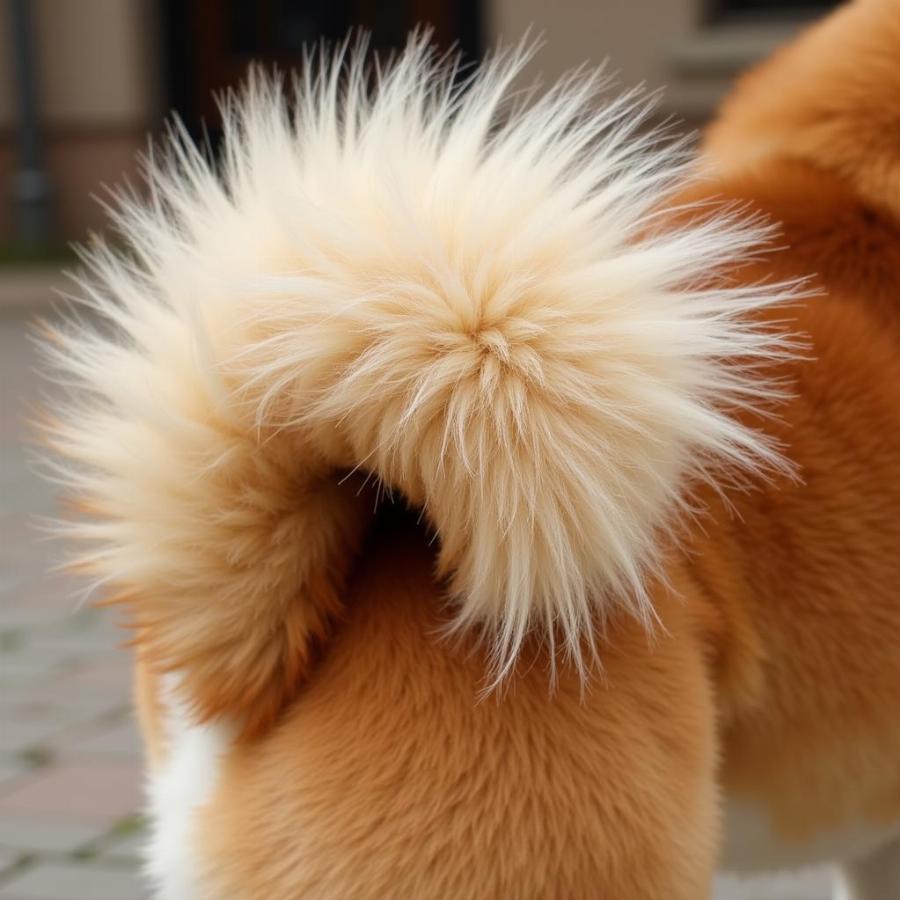Curly tails are an endearing trait found in various dog breeds, often adding a touch of unique charm to their overall appearance. But is there more to a curly tail than just aesthetics? This comprehensive guide will explore everything you need to know about dogs with curly tails, from breed identification to understanding the significance of this quirky characteristic. We’ll delve into the genetics behind curly tails, discuss popular curly-tailed breeds, and address common questions about care and potential health concerns.
Unveiling the Mystery of the Curly Tail
Why do some dogs have curly tails while others don’t? The answer lies in genetics. A specific gene influences the development of a curly tail in dogs. It’s important to note that the curl can vary significantly, from a slight curve to a tight, almost circular spiral. The tightness of the curl is often breed-specific and can even vary within the same breed. While generally harmless, it’s crucial to differentiate a naturally curly tail from one that might be a sign of an underlying health issue. So how can you tell the difference? A naturally curly tail is present from birth and remains consistent throughout the dog’s life. A sudden change in tail carriage or curl could indicate a problem and warrants a visit to the veterinarian.
Popular Curly Tail Dog Breeds
Several breeds are known for their characteristic curly tails. Some of the most popular include Poodles, known for their tight, sometimes elaborately groomed curls; Shiba Inus, with their signature curled-over “brush” tail; and Pugs, whose tails often curl tightly against their backs. Other examples include Akitas, Basenjis, and Chow Chows, each with its distinctive curl. Understanding the breed-specific nuances of the curly tail can help potential owners appreciate the unique characteristics of these dogs.
 Shiba Inu with a Curly Tail
Shiba Inu with a Curly Tail
Caring for Your Curly-Tailed Companion
Caring for a dog with a curly tail is similar to caring for any other dog. However, some breeds with particularly tight curls, like Poodles, may require specific grooming attention to prevent matting and skin irritation. Regular brushing and occasional trimming are essential. For breeds with less tightly curled tails, routine grooming is usually sufficient.
Curly Tail FAQs
What causes a dog’s tail to curl? As mentioned earlier, genetics are the primary factor determining a dog’s tail curl.
Is a curly tail a sign of a health problem? A naturally curly tail present from birth is generally not a health concern. However, a sudden change in tail curl or carriage could indicate an issue and should be checked by a vet.
Do all dogs with curly tails need special grooming? Not all, but breeds with tight curls, such as Poodles, often require more attention to prevent matting and skin problems. You might be interested in learning more about specific breeds, such as small dogs with curly tails or big dogs with curly tails. We have articles dedicated to both!
Are there any health problems associated with curly tails? In some cases, very tightly curled tails can lead to a condition called “ingrown tail,” which can cause discomfort and infection. This is more common in breeds with extremely tight curls.
Can a dog’s tail become uncurled? A naturally curly tail generally remains curled throughout the dog’s life. While the tightness might slightly change with age, it’s unlikely to completely uncurl. For instance, poodles for hunting dogs, despite their active lifestyle, retain their signature curly tails.
Living with a Curly-Tailed Dog
Bringing a curly-tailed dog into your life can be a rewarding experience. These dogs come in various sizes and personalities, from the energetic Shiba Inu to the affectionate Pug. Remember, choosing a dog should always be based on your lifestyle and ability to meet the breed’s specific needs. A white curly haired dog, like a Bichon Frise, might be a good fit for those with allergies, while a miniature goldendoodle dogs could be perfect for families.
Conclusion
Curly tails are a charming and distinctive feature found in a variety of dog breeds. While largely an aesthetic trait, understanding the genetics and breed-specific nuances of curly tails can help owners appreciate and care for their canine companions. From the playful curl of a Pug to the elegant plume of a Poodle, curly tail dogs bring a unique charm to the world of canines.
Frequently Asked Questions
- What are some common curly-tailed dog breeds?
- How do I groom a dog with a curly tail?
- Is a curly tail ever a sign of a health problem?
- Do curly-tailed dogs require special care?
- Where can I find more information about specific curly-tailed breeds?
- Are there any health issues specific to curly tails?
- Can a curly tail become uncurled over time?
Further Exploration
Looking for more information on specific breeds? Check out our other articles on related topics.
Beaut Dogs is your go-to resource for all things related to our canine companions. We offer a wealth of information on breed characteristics, care tips, and much more. From understanding the nuances of different breeds to providing expert advice on training and nutrition, Beaut Dogs is here to help you navigate the wonderful world of dog ownership. When you need expert guidance, reach out to us at [email protected] for detailed and accurate answers. We’re dedicated to empowering you with the knowledge and resources you need to provide the best possible care for your beloved furry friend. Visit https://beautdogs.com today!